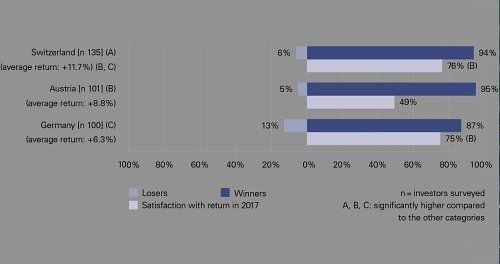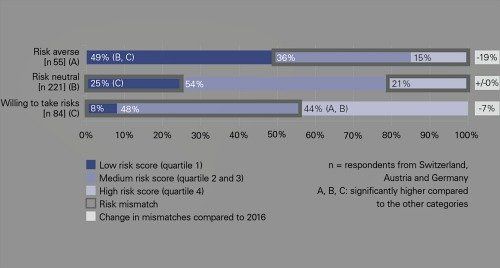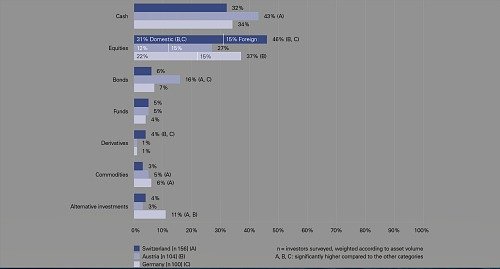On average, private investors are not diversified enough and their perception of the level of risk in their portfolio is often not in line with their risk appetite, a study by LGT reaveals.
By Julia Scheyer, responsible for LGT market research projects
Regardless of how markets develop – the portfolios of high-net-worth private banking clients always look more or less the same. This is reflected in the results of the LGT Private Banking Reports that have been published since 2010.
Despite the current interest rate situation, these clients currently hold a lot of cash in addition to equities and bonds, and therefore remain faithful to their usual asset mix (see Figure 1).
Average Asset Allocation (country comparison)
[Cash/Equities/Bonds/Funds/Derivatives/Commodities/Alternative investments, Domestic/Foreign, Switzerland/Austria/Germany, n = investors surveyed, weighted according to asset volume, A, B, C: significantly higher compared to the other categories]
Other asset classes that could serve to improve diversification, in particular commodities or alternative investments, account for a significantly smaller share of the portfolios of high-net-worth investors.
Too Many Eggs in One Basket
For example, the respondents in Switzerland invest an average of 78 percent of their assets in cash (32 percent) and equities (46 percent), and only 22 percent in other asset classes. The average portfolio of German respondents has a somewhat higher share of alternative investments in comparison (11 percent vs. 4 percent) – they are therefore slightly more diversified than the Swiss.
Notwithstanding, the overall results show that the private banking respondents in all three countries have «too many eggs in one basket» when it comes to their portfolios.
Suboptimal in The Long Term
According to the study, investors that reach their investment decisions together with a relationship manager are generally better diversified than investors who make their decisions without a relationship manager.
In order for private investors to implement the «don’t put all your eggs in one basket» principle to a greater degree, it would appear that banks and relationship managers must more clearly explain the opportunities and risks associated with the various asset classes. Although the respondents’ asset allocation is suboptimal in the long term, they achieved good results last year and are satisfied with these (see Figure 2).
Returns And Satisfaction With Returns (country comparison)

[Switzerland (average return: )/Austria (average return: )/Germany (average return), Losers/Winners/Satisfaction with return in 2017, n = investors surveyed, A, B, C: significantly higher compared to the other categories]
According to the information provided by the respondents, the Swiss private investors achieved an average return of 11.7 percent in 2017, the Austrians 8.8 percent and the Germans 6.3 percent. As the figures would suggest, the Swiss are the most satisfied with their returns of 11.7 percent (76 percent).
Achieving Higher Returns
Interesting, however, is that the German investors are more satisfied with their return of 6.3 percent (75 percent) than the Austrians (49 percent). And this despite the Austrian respondents achieving higher returns (8.8 percent), lower losses (5 percent vs. 13 percent) and higher gains (95 percent vs. 87 percent) than the investors in Germany.
The Austrian respondents are significantly more critical than the Germans in this area.
Mismatches Often Exist
How do high-net-worth private banking clients perceive the risk associated with their investments? In theory, a risk-averse investor should have a low-risk portfolio and an investor who is willing to take risks a riskier portfolio (= match between portfolio risk and individual risk appetite).
The results of the LGT Private Banking Report, however, show that a mismatch often exists: 51 percent of risk-averse respondents perceive their portfolio risk as being medium to high, while 56 percent of the respondents who are willing to take risks see their portfolio as being low to medium risk (see Figure 3).
Risk Appetite And Personal Portfolio Risk Score

[Risk averse, Risk neutral, Willing to take risks, Low risk score (quartile 1)/Medium risk score (quartile 2 and 3)/High risk score (quartile 4)/Risk mismatch/Change in mismatches compared to 2016, n= respondents from Switzerland, Austria and Germany, A, B, C: significantly higher compared to the other categories]
This means that for around half of respondents, the perception of the level of risk in their portfolio is not in line with their individual risk appetite (= mismatch). It would appear that the client risk classification conducted as part of the advisory process does not function optimally in these cases.
Introducing Greater Diversification
The mismatch could be attributable to the difference in how risks are perceived: it is possible that a relationship manager views the risk associated with an asset class differently than a client. These subjective differences in the perception of risks should be given greater importance during the advisory process in order to counteract risk mismatches and to align portfolios with the client’s wishes.
Banks and relationship managers should consider placing greater focus on explaining the different investment possibilities and the associated opportunities and risks so that clients add some variety to their portfolios, introduce greater diversification and in doing so, can also better steer the risks contained in these portfolios.

Julia Scheyer studied Strategic Management at Leopold Franzens University in Innsbruck, Austria. Following a stay abroad in London, she graduated from LGT’s Graduate Program in the Marketing and Communication department, where she is now responsible for supporting and implementing various market research projects.
The LGT Private Banking Report 2018 was published in June. It has been conducted every two years on behalf of LGT since 2010. The objective of the report is to gain important insights into the investment behavior and attitudes of private banking clients. Around 360 high-net-worth private individuals from Germany, Austria and Switzerland with investable assets of over 500,000 euros or 900'000 francs are surveyed to this end. The author of this representative scientific study is Professor Teodoro D. Cocca of the University of Linz, Austria.












